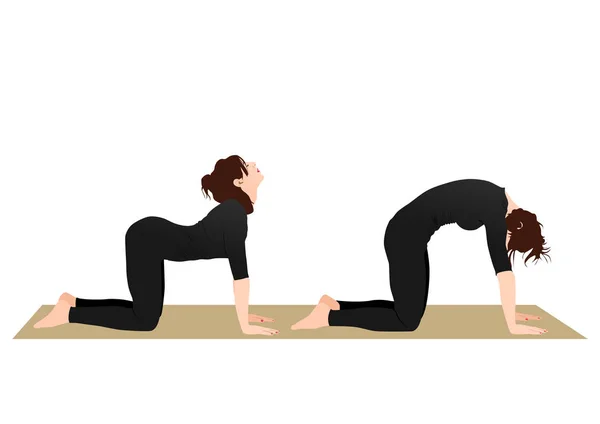Sensation, and back pain are grievances that are associated with age and spare no one, hence may lead to alterations in one’s lifestyle. Despite these solutions, it is now gingerly becoming clear that yoga is perhaps the best natural solution to the problem of back pain among many individuals. The upside of yoga is that the muscles, which hold the spine, are toned, flexibility is boosted, stress levels lowered and the body and mind in general are benefited. Let us in this article briefly discuss what may well turn out to be the five most helpful yoga asanas that can minimize back pain issues and just how executing them may help.
1. Cat-Cow Pose (Marjariasana-Bitilasana)
Cat-Cow is an excellent warm-up exercise that can help stretch back muscles and increase the spine’s flexibility. It entails flexion and extension of the spine – The cat extends her spine to the ceiling, contracts it to the floor and then rolls to her stomach and traces the same path.
How to perform:
- Kneel on the floor and place the palms and the knees on the floor, with the fingers pointing forward and the knees pointing backward.
- Like the Cow pose, take a deep breath and while exhaling, pull the abdomen towards the floor and look up.
- It has been found that the sequence of movements should be as follows, ‘inhale, lower the legs toward the floor, extend the arms to the sides – exhale, round the back towards the spine, tuck the chin toward the chest – inhale’.
- Perform this flowing movement with as many breaths as possible up to 5-10 breaths.
Benefits:
- muscles and abdominal muscles taken to their limits.
- Promotes flexibility and price of the spinal section.
- Reduces tension and rigidity in the area of the back.
2. Child’s Pose (Balasana)

The child’s pose is a very mild asana that relieves lower back pain and draws concentration towards relieving tension in the back and shoulder. Make a good sitting position if one wants to take some rest or to untwining the mind.
How to perform:
- Kneel on your mat with your knees and your feet slightly wider than shoulder width and your toes touching each other.
- Breathe out and lean your body back onto your heels, reaching the hands forward and towards the mat.
- By your sides, with your hands out in front of you at a comfortable distance or with your hands beside or behind you with your palms facing the floor.
- It can be held for about 5-10 breaths where the client has to keep a given position while the nurse breathes.
Benefits:
- Helps in touching the toe by bending the knees and stretching the lower back, hips, and thigh regions.
- Reduces anxiety and stress and refreshes to drowsiness.
- Stimulates tired and nervous people and makes them calm and relaxed.
3. Locust Pose (Salabhasana)

Locust pose is a backbend that helps develop muscles of the back and the posture of the body. This can assist one in easing lower back pain and decrease muscle tightness in the upper back as well as on the shoulders.
How to perform:
- First, one has to lay face down on the mat and place the arms ahead of you and the legs together.
- Inhale and kick the position of the mat, raise your chest, arms, and legs off the floor, but allow your navel to stay on the mat.
- Stand or sit with your hands for 5-10 breaths and inhale deeply.
- Exhale and slowly return to the initial position; with the feet shoulder-width apart and the hands crossed at the chest level.
Benefits:
- This exercise helps strengthen the muscles at the back particularly the erector spinae muscles and the muscles at the shoulder blades.
- It enhances posture as well as the arrangement of the spinal column.
- Shifting of the movements from the spine and shoulders making them more flexible.
4. Seated Forward Bend (Paschimottanasana)

Seated Forward Bend is an easy yoga pose that may be useful for the lower back and hamstring muscles. It is a relaxing posture that could be used in the enforcement of needed rest or stress-free conditions.
How to perform:
- Stand with your feet shoulder-width apart and fold your body down until you sit on your heels with your back straight.
- Breathe in and keep the breath in as you lift both your arms above your head.
- Breathe out and bend forward at the hips, attempting to touch the toes or go as low as you can.
- Maintain this position for 5-10 breaths, fully inhaling and exhaling.
Benefits:
- Stretches the hamstrings lower back and spine.
- Helps to relax and tender muscles in the back.
- Helps to get a break and to feel less pressure.
5. Bridge Pose (Setu Bandha Sarvangasana)

The Bridge pose is created with careful orientation from the feet to the back of the head and can be used to relieve the pain in the lower back and work on the flexibility of the spinal column. It also helps elongate the chest, neck, and shoulder muscles and hence helps to facilitate better posture.
How to perform:
- Lay down on your back and fold your knees towards your chest, keep your feet on the floor with a hip-width distance and the soles facing each other.
- Breathe out, and use your abdominal muscles and your tail to move your hips up off the floor: aim to create a straight line from the knees to the shoulders.
- Curl your fingers and cross them in front of you, or behind your back if you prefer using your hands to help balance while dancing.
- Make sure to keep the position for 5-10 breaths, inhaling fully.
- Release all the air and lower your back gradually to the floor.
Benefits:
- Helps to massage the chest, neck, and shoulder muscles as well as extend them.
- It strengthens back muscles and makes an individual have a good posture.
- It helps to manage pain and stiffness in the lumbar region of the back.
Integrating these yoga asanas into your schedule can enable you to get rid of back pain and make your muscles more flexible and strong. But at the same time, it’s imperative to follow the pain and avoid certain positions that cause pain or intensify already existing pain. Also, it is always recommended to consult the services of a certified yoga trainer to avoid having a poor form that may lead to injuries.
There is always discomfort or pain in the back especially if one is a victim of the backache, however, practicing yoga asanas can assist in reducing the pain. Five asanas described in the current article include the cat-cow pose, the child’s pose, and the locust pose as well as the seated forward bend and the bridge pose; all these poses work on different parts of the back and can alleviate back pain through strength, flexibility, and stretching. Please make sure your practice is careful and if you doubt anything you’re doing, check with a certified instructor. It should come as a revelation that by incorporating yoga as a component of your back pain, then one can effectively participate in managing their back pain and at the same time improve their quality of life.
Can yoga help with chronic back pain?
In a nutshell, exercising through the numerous forms of yoga can help people with continuing back pain. Yoga asanas contribute to the building up of back muscles and increased flexibility besides decreasing inflammation processes; this can help in eradicating chronic pain.
Can one perform yoga exercises for a herniated disc patient?
However, it is wise always to seek the approval of a doctor or a qualified instructor in yoga especially when you have a herniated disc. Some particular asanas should either be done differently or be excluded from the practice together due to the risks of worsening the aforementioned ailment.
In how many sessions of the day can I do these yoga asanas to get rid of back pain?
These asanas are best done daily or at least weekly, for the best effects, going as far as 3-4 times per week. Nevertheless, it is necessary to pay attention to the signals of the body and use modifications in the frequency and intensity of physical exercises.
Are all of these asanas possible in pregnancy?
While some of these asanas can be done later in pregnancy with certain adjustments is advisable to seek advice from a person trained in prenatal yoga or your gynecologist.
There are many benefits we get by doing yoga which you can share with us through the online feedback system.
Here are some other articles related to your search:






